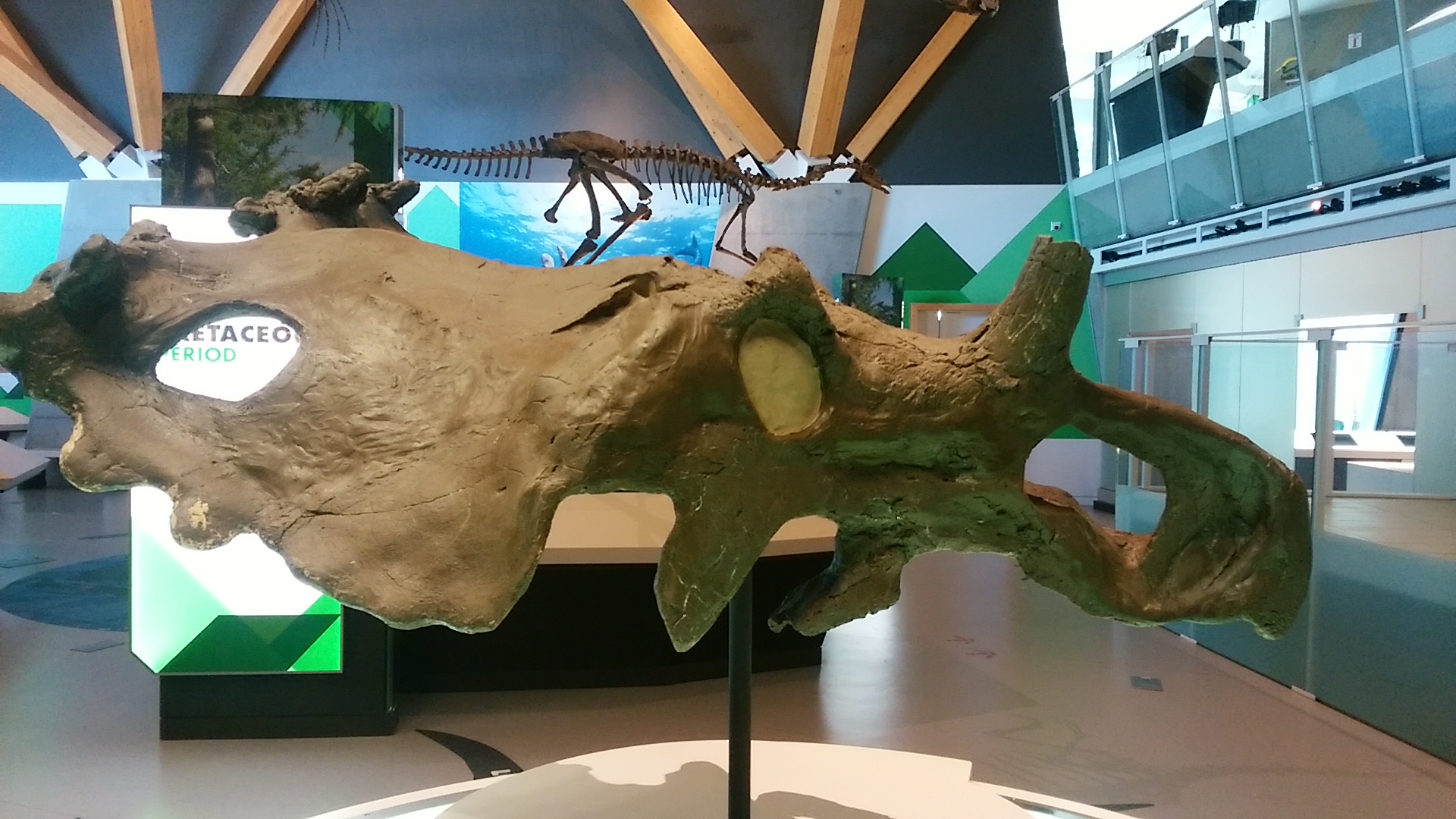|
Centrosaurinae
Centrosaurinae (from the Greek, meaning "pointed lizards") is a subfamily of ceratopsid, a group of large quadrupedal ornithischian dinosaur. Centrosaurine fossil remains are known primarily from the northern region of Laramidia (modern day Alberta, Montana, and Alaska) but isolated taxa have been found in China and Utah as well. Defining features of centrosaurines include a large nasal horn, short supratemporal horns, and an ornamented frill projecting from the back of the skull. With the exception of '' Centrosaurus apertus'', all adult centrosaurines have spike-like ornaments midway up the skull. Morphometric analysis shows that centrosaurines differ from other ceratopsian groups in skull, snout, and frill shapes. There is evidence to suggest that male centrosaurines had an extended period of adolescence, and sexual ornamentation did not appear until adulthood. Centrosaurinae was named by paleontologist Lawrence Lambe in 1915, with '' Centrosaurus'' as the type genus. It is ... [...More Info...] [...Related Items...] OR: [Wikipedia] [Google] [Baidu] |
Nasutoceratops
''Nasutoceratops'' is a genus of ceratopsid dinosaur that lived in North America during the Late Cretaceous period, about 76.0–75.5 million years ago. The first known specimens were discovered in Utah in the Kaiparowits Formation of the Grand Staircase–Escalante National Monument (GSENM) from 2006 onwards, including a subadult skull with both a partial postcranial skeleton and rare skin impressions, and two other partial skulls. In 2013, the subadult was made the holotype of the new genus and species ''Nasutoceratops titusi''; the generic name means "large-nosed horned face", and the specific name honors the paleontologist Alan L. Titus for his work at the GSENM. The dinosaur was noted for its large nose in news reports, and later featured in ''Jurassic World'' films. The holotype skull of ''Nasutoceratops'' is approximately long; its body length has been estimated at , and its weight at . ''Nasutoceratops'' is distinct in features such as the snout region being unusually ... [...More Info...] [...Related Items...] OR: [Wikipedia] [Google] [Baidu] |
Achelousaurus
''Achelousaurus'' () is a genus of Centrosaurinae, centrosaurine ceratopsid dinosaur that lived during the Late Cretaceous, Late Cretaceous Period of what is now North America, about 77 to 74.8 million years ago. The first fossils of ''Achelousaurus'' were collected in Montana in 1987, by a team led by Jack Horner (paleontologist), Jack Horner, with more finds made in 1989. In 1994, ''Achelousaurus horneri'' was described and named by Scott D. Sampson; the generic name means "Achelous lizard", in reference to the Greek deity Achelous, and the specific name (zoology), specific name refers to Horner. The genus is known from a few specimens consisting mainly of skull material from individuals, ranging from juveniles to adults. A large centrosaurine, ''Achelousaurus'' supposedly was about long, with a weight of about . As a ceratopsian, it walked on all fours, had a short tail and a large head with a hooked beak. It had a bony neck-frill at the rear of the skull, which sport ... [...More Info...] [...Related Items...] OR: [Wikipedia] [Google] [Baidu] |
Einiosaurus
''Einiosaurus'' is a genus of herbivorous centrosaurine ceratopsian dinosaur from the Upper Cretaceous (Campanian stage) of northwestern Montana. The name means 'bison lizard', in a combination of Blackfoot language, Blackfeet Indian ''eini'' and Latinized Ancient Greek ''sauros''; the specific name (zoology), specific name (''procurvicornis'') means 'with a forward-curving horn' in Latin. ''Einiosaurus'' is medium-sized with an estimated body length at . History of discovery Horner's expeditions to Landslide Butte ''Einiosaurus'' is an exclusively Montanan dinosaur, and all of its known remains are currently held at the Museum of the Rockies in Bozeman, Montana. At least fifteen individuals of varying ages are represented by three adult skulls and hundreds of other bones from two low-diversity, monospecific (one species) bonebeds, which were discovered by John R. Horner, Jack Horner in 1985 and excavated from 1985 to 1989 by Museum of the Rockies field crews. Horner had not bee ... [...More Info...] [...Related Items...] OR: [Wikipedia] [Google] [Baidu] |
Machairoceratops
''Machairoceratops'' (meaning "bent sword horned face"), previously known as the "Wahweap centrosaurine B", is an extinct genus of centrosaurine ceratopsian dinosaur known from the Late Cretaceous Wahweap Formation (late Campanian stage) of Grand Staircase–Escalante National Monument, southern Utah, United States. Discovery It contains a single species, ''M. cronusi'', first described and named in 2016 in paleontology, 2016 by Eric K. Lund, Patrick M. O’Connor, Mark A. Loewen, and Zubair A. Jinnah. The name of a biological genus, generic name is derived from Greek language, Greek ''machairis'', meaning "bent sword", in reference to its unique frill ornamentation showing two forward curving horns on the frill's uppermost part, and Latinized Greek ''ceratops'', meaning "horned-face", which is a common suffix for ceratopsian genera names. The specific name (zoology), specific name ''cronusi'' refers to Cronus, a Greek god who deposed his father Uranus (mythology), Uranus by ca ... [...More Info...] [...Related Items...] OR: [Wikipedia] [Google] [Baidu] |
Centrosaurus Apertus
''Centrosaurus'' ( ; ) is a genus of centrosaurine ceratopsian dinosaur from Campanian age of Late Cretaceous Canada. Their remains have been found in the Dinosaur Park Formation, dating from 76.5 to 75.5 million years ago. Discovery and naming The first ''Centrosaurus'' remains were discovered and named by paleontologist Lawrence Lambe in strata along the Red Deer River in Alberta. The name ''Centrosaurus'' means "pointed lizard" (from Greek ', , "point" and ', , "lizard") and refers to, the series of small hornlets placed along the margin of their frills, not the nasal horns (which were unknown when the dinosaur was named). The genus is not to be confused with the stegosaur ''Kentrosaurus'', the name of which is derived from the same Greek word. Later, vast bonebeds of ''Centrosaurus'' were found in Dinosaur Provincial Park, also in Alberta. Some of these beds extend for hundreds of meters and contain thousands of individuals of all ages and all levels of completion. Scie ... [...More Info...] [...Related Items...] OR: [Wikipedia] [Google] [Baidu] |
Medusaceratops
''Medusaceratops'' is an extinct genus of Centrosaurinae, centrosaurine ceratopsian dinosaur known from the Late Cretaceous Judith River Formation (middle Campanian stage) of Montana, northern United States. It contains a single species, ''Medusaceratops lokii''.Ryan, Michael J.; Russell, Anthony P., and Hartman, Scott. (2010). "A New Chasmosaurine Ceratopsid from the Judith River Formation, Montana", In: Michael J. Ryan, Brenda J. Chinnery-Allgeier, and David A. Eberth (eds), ''New Perspectives on Horned Dinosaurs: The Royal Tyrrell Museum Ceratopsian Symposium'', Indiana University Press, 656 pp. . Discovery The known material of ''Medusaceratops'' came from a bonebed in the badlands on the west side of Kennedy Coulee adjacent to the Milk River (Alberta–Montana), Milk River, in the Milk River Natural Area, near Havre, Montana, Havre, Hill County, Montana, Hill County of Montana. The material was first reported by Sweeney and Boyden (1993), who considered it to represent the ... [...More Info...] [...Related Items...] OR: [Wikipedia] [Google] [Baidu] |
Sinoceratops
''Sinoceratops'' is an extinct genus of ceratopsian dinosaur that lived from 77.3 to 73.5 million years ago during the latter part of the Cretaceous Period in what is now Shandong province in China. It was named in 2010 by Xu Xing ''et al.'' for three skulls from Zhucheng, China. The name of its type species ''Sinoceratops zhuchengensis'' means "Chinese horned face from Zhucheng", after the location of its discovery. ''Sinoceratops'' was a medium-sized, averagely-built, ground-dwelling, quadrupedal herbivore. It could grow up to an estimated in length and weigh up to . It was the first ceratopsid dinosaur discovered in China, and the only ceratopsid known from Asia. All other centrosaurines, and all chasmosaurines, are known from fossils discovered in North America, except for possibly ''Turanoceratops''. ''Sinoceratops'' is also significant because it is one of the largest known centrosaurines, and is much larger than any other known basal members of this group. ''Sinocerat ... [...More Info...] [...Related Items...] OR: [Wikipedia] [Google] [Baidu] |
Lokiceratops
''Lokiceratops'' (meaning "Loki horned face") is an extinct genus of centrosaurine ceratopsian dinosaurs from the Late Cretaceous (Campanian) Judith River Formation of Montana, United States. The genus contains a Monotypic taxon, single species, ''L. rangiformis'', known from most of the skull and a partial skeleton. Four other ceratopsians are known from the same Stratigraphic unit, stratigraphic interval as ''Lokiceratops''—more than in any other locality—suggesting that this clade was very diverse during the Late Cretaceous of northern Laramidia. Discovery and naming The ''Lokiceratops'' holotype specimen, Knuthenborg Safaripark#Dinosaur Forest and Museum of Evolution, EMK 0012, was discovered by Mark Eatman in 2019 in the Loki Quarry, representing outcrops of the Judith River Formation (McClelland Ferry Member) in the Kennedy Coulee. This locality is situated in the badlands near Milk River (Alberta–Montana), Milk River and the town of Rudyard, Montana, Rudyard ... [...More Info...] [...Related Items...] OR: [Wikipedia] [Google] [Baidu] |
Styracosaurus
''Styracosaurus'' ( ; meaning "spiked lizard" from the Ancient Greek / "spike at the butt-end of a spear-shaft" and / "lizard") is an extinct genus of herbivorous ceratopsian dinosaur from the Late Cretaceous (Campanian stage) of North America. It had four to six long parietal spikes extending from its neck frill, a smaller jugal horn on each of its cheeks, and a single horn protruding from its nose, which may have been up to long and wide. The function or functions of the horns and frills have been debated for many years. ''Styracosaurus'' was a relatively large dinosaur, reaching lengths of and weighing about . It stood about tall. ''Styracosaurus'' possessed four short legs and a bulky body. Its tail was rather short. The skull had a beak and shearing cheek teeth arranged in continuous dental batteries, suggesting that the animal sliced up plants. Like other ceratopsians, this dinosaur may have been a herd animal, travelling in large groups, as suggested by bone beds. N ... [...More Info...] [...Related Items...] OR: [Wikipedia] [Google] [Baidu] |
Coronosaurus
''Coronosaurus'' is a genus of centrosaurine ceratopsian dinosaurs which lived in the Late Cretaceous, in the middle Campanian stage. Its remains, two bone beds, were discovered by Phillip J. Currie in the Oldman Formation of Alberta, Canada, and its type and only species, ''Coronosaurus brinkmani'', was first described in 2005, as a new species within the genus ''Centrosaurus''. Later studies questioned the presence of a direct relationship, and in 2012 it was named as a separate genus. ''Coronosaurus'' means "crowned lizard", coming from "''corona''", Latin for crown, and "''sauros''", Greek for lizard; this name refers to the unique, crown-like shape of the horns on the top of its frill. Like other ceratopsids, ''Coronosaurus'' had a large frill and horns on its head. These include a small pair of brow horns over its eyes, a large nasal horn on its snout, and, unique among ceratopsians, irregular, spiky bone masses on its frill. Growing up to around long and in weight, i ... [...More Info...] [...Related Items...] OR: [Wikipedia] [Google] [Baidu] |
Yehuecauhceratops
''Yehuecauhceratops'' (meaning "ancient horned face") is a genus of horned centrosaurinae, centrosaurine ceratopsidae, ceratopsid dinosaur from the Late Cretaceous of Coahuila, Mexico. It contains a single species, ''Y. mudei'', described from two partial specimens by Rivera-Sylva ''et al.'' in 2016 and formally named by Rivera-Sylva ''et al.'' in 2017. It was a small centrosaurine with a body length of , making it smaller than ''Agujaceratops'' and ''Coahuilaceratops'', the other two ceratopsids in its environment; the three may have been ecologically segregated. A ridge bearing a single roughened projection near the bottom of the squamosal bone, which probably supported a small horn, allows ''Yehuecauhceratops'' to be distinguished from other centrosaurines. Its affinities to nasutoceratopsin centrosaurines, such as ''Avaceratops'' and ''Nasutoceratops'', are supported by various morphology (biology), morphological similarities to the former. Discovery and naming Specimens of ... [...More Info...] [...Related Items...] OR: [Wikipedia] [Google] [Baidu] |









